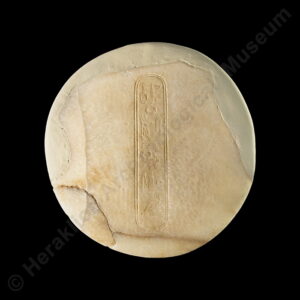
The Royal Cartouche in ancient Egypt was a stylised vertical or horizontal tablet in the shape of an oval loop with a line at one end tangent to the oval, enclosing the royal name of the Pharaoh. It is found in written texts and painted or incised on objects, mainly sarcophagi, artefacts and statues as the owner’s “label”, as well as on amulets. In Egyptian hieroglyphs the sign of the closed loop cartouche symbolises all that is enclosed by the sun, emphatically stressing the ruler’s dominion over the universe. Cartouches are important evidence in archaeological assemblages for identifying the pharaoh and dating purposes. Imported Egyptian objects bearing royal cartouches in Crete provide important information on the chronological correlations of the two civilisations. They are also evidence of the close relations between the Minoan palatial centres and Egypt, and of the wide circulation of status objects in the East Mediterranean during the Late Bronze Age.